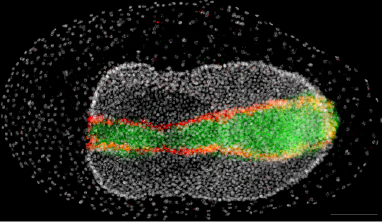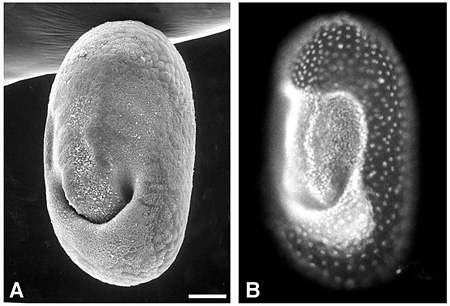The Evolution of axis formation and gastrulation in insects
Main areas of research:
- Evolution of cell-cell communication and gene regulation in insects
- Mechanisms of self-regulatory patterning and scaling
- Evolution of morphogenetic processes
- The influence of ecology on the evolution of development
Research from the last decades has revealed that many developmental and cellular processes show a striking degree of conservation throughout the animal kingdom from jellyfish to mammals. Findings from invertebrate model systems like the fruit fly Drosophila melanogaster can often be directly transferred to vertebrates including humans. How can one, however, reconcile the striking diversity of body plans with the existence of highly conserved developmental mechanisms? To address this question we study the evolution of developmental mechanisms. Our focus is dorsoventral (DV) axis formation, which has been extensively analyzed in the fruit fly Drosophila and represents one of the best-understood developmental processes.
In Drosophila the DV axis is mostly patterned by a gradient of Toll signaling, a pathway which is not known for a patterning role in other animals, but rather for a highly conserved function in innate immunity. In contrast, the DV axis of other animals is established by a BMP signaling gradient, which in Drosophila has a more limited Toll-dependent function. In recent years our lab has shown that BMP signaling progressively replaces Toll signaling in insects which are members of more basal branches of the phylogenetic tree, like beetles, wasps and bugs. This work relates the derived mode of DV patterning in Drosophila to the more ancestral BMP-based mode found in other animals.
Interestingly, the greater influence of BMP signaling in basally branching insects is frequently linked to a high degree of pattern regulation not observed in Drosophila. For example, such insects can form two or more embryos within one egg. We are studying the molecular mechanism underlying this fascinating phenomenon and try to correlate the degree of pattern regulation with life history traits. We also analyze Toll-based innate immunity in basal insects as we assume that the patterning function of Toll was recruited from an ancestral function of Toll in protecting insect eggs against pathogens. These projects provide an ecological perspective to the evolution of development.

